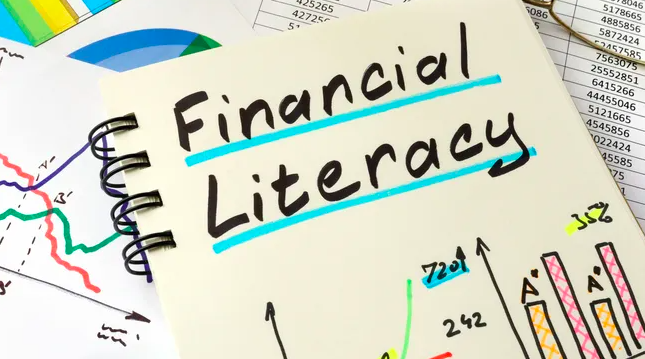Financial literacy is the ability to understand and effectively use various financial skills. This includes understanding personal financial management, budgeting, saving, investing, and making informed financial decisions. It equips individuals with the knowledge and skills necessary to navigate the complex world of money, enabling them to make informed choices and secure their financial well-being.
In today’s society, where financial decisions have far-reaching consequences, promoting financial literacy has become more crucial than ever before.
Teaching children about money management and financial literacy is more important than ever before. By inculcating financial literacy skills at an early age, we can empower children to make informed decisions, develop responsible habits, and lay the groundwork for a financially secure future.

Why is Financial Literacy Important?
1. Personal Financial Management: Financial literacy helps individuals develop sound money management skills. It enables them to create budgets, track expenses, and make wise financial decisions that align with their goals and values. With financial literacy, individuals can prioritise saving, manage debt effectively, and avoid unnecessary financial stress.
2. Informed Decision Making: Financial literacy equips individuals with the ability to critically analyze financial information and evaluate the potential risks and benefits of various options. It helps them make informed decisions regarding investments, loans, insurance, and retirement planning. By understanding financial concepts, individuals can protect themselves from scams, fraud, and predatory financial practices.
3. Economic Stability: A financially literate society contributes to overall economic stability. When individuals understand the importance of saving, investing, and responsible borrowing, they are less likely to fall into debt traps or experience financial crises. Financially stable individuals contribute to a strong economy by participating in productive investments, entrepreneurial endeavours, and responsible consumption.
4. Generation of Wealth: Financial literacy empowers individuals to build and accumulate wealth over time. It enables them to understand the power of compounding, differentiate between various investment options, and take advantage of opportunities to grow their assets. With financial literacy, individuals can break the cycle of financial instability and create a foundation for generational wealth.
Here we will discuss the significance of financial literacy for kids and how positively it impacts their lives.
1. Developing Healthy Financial Habits:
Introducing financial literacy to children helps them cultivate healthy financial habits from an early age. They learn the value of money, the importance of saving, and the concept of delayed gratification. By understanding basic financial principles, kids become less impulsive and more responsible with their spending. They learn to distinguish between wants and needs, make thoughtful purchase decisions, and avoid falling into the trap of excessive consumerism.
2. Building Financial Confidence:
Financial literacy empowers children by giving them the confidence to manage their money. Through age-appropriate education, they learn about earning, saving, and spending. They understand the significance of budgeting and develop the skills to allocate their resources wisely. With this knowledge, children become active participants in their financial lives, capable of setting financial goals and making informed choices aligned with their aspirations.
3. Developing Critical Thinking and Problem-Solving Skills:
Financial literacy promotes critical thinking and problem-solving skills in children. They learn to analyze and evaluate financial decisions based on their long-term consequences. They develop the ability to assess risks, compare options, and consider trade-offs. Such critical thinking skills are transferable to various aspects of life and are essential for making well-informed decisions in any field.
4. Navigating an Ever-Changing Financial Landscape:
In today’s technologically advanced world, financial transactions are increasingly digital. Teaching kids about online banking, digital payments, and online security equips them with the knowledge to navigate this digital landscape safely and confidently. By educating children about concepts such as identity theft, phishing scams, and online privacy, they can protect themselves from potential financial pitfalls in the digital realm.
5. Fostering Long-Term Financial Well-being:
By introducing financial literacy to children early on, we set them on a path towards long-term financial well-being. They learn about the benefits of saving for the future, investing wisely, and planning for major life events such as college or retirement. With a solid foundation in financial literacy, children are better prepared to handle financial challenges, adapt to economic changes, and achieve their financial goals throughout their lives.
Below we are discussing a few ways to teach Financial Literacy for Kids:
1. Education in Schools:
Incorporating financial literacy into school curricula ensures that children receive consistent and structured learning opportunities. Schools can teach financial concepts through interactive activities, simulations, and practical examples that resonate with children.
2. Involvement of Parents:
Parents play a crucial role in promoting financial literacy for kids. By discussing money matters openly, involving children in family budgeting decisions, and providing hands-on experiences such as allowance management, parents can instill essential financial skills and values.
3. Educational Resources:
Accessible educational resources, including books, games, online platforms, and apps, can engage children in interactive and age-appropriate financial learning. These resources should be designed to make learning about money engaging, enjoyable, and relatable for children.
4. Community Programs and Partnerships:
Collaborations between schools, community organisations, and financial institutions can provide workshops, seminars, and events focused on financial literacy for kids. These programs offer opportunities for children to interact with experts, learn practical skills, and participate in real-world financial simulations.
Kids can learn financial literacy through a combination of formal education, practical experiences, and ongoing discussions about money management.
Here are some effective ways for kids to learn financial literacy:
1. School Curriculum:
Financial literacy should be integrated into the school curriculum at various grade levels. Schools can introduce basic financial concepts, such as earning, saving, budgeting, and investing, through age-appropriate lessons and activities. This can include real-life scenarios, interactive games, and simulations that help children understand the value of money and how to make informed financial decisions.
2. Allowance and Money Management:
Giving children an allowance provides a practical opportunity for them to learn money management skills. Parents can teach kids how to budget their allowance, save for goals, and make choices about spending. Encourage them to allocate a portion of their allowance towards savings, charity, and discretionary spending, helping them develop responsible financial habits.
3. Financial Discussions at Home:
Parents should openly discuss financial matters with their children, explaining how money works, the importance of saving, and the potential consequences of overspending or borrowing. Regular conversations about family budgeting, grocery shopping, and financial planning for vacations can help children understand the real-world applications of financial concepts.
4. Setting Savings Goals:
Encourage children to set savings goals for things they want to buy or experiences they wish to have. This teaches them the value of saving, delayed gratification, and goal-setting. Help them track their progress and celebrate their achievements when they reach their savings targets.
5. Real-Life Experiences:
Engage children in real-life financial experiences, such as opening a bank account, accompanying parents to the grocery store, or assisting with budgeting for a family outing. These experiences provide hands-on learning opportunities where children can witness the practical aspects of money management.
6. Online Educational Resources:
Utilise reputable online resources and websites dedicated to financial literacy for kids. These platforms often offer interactive games, videos, and educational materials that make learning about money fun and engaging. Supervise their online activities and guide them in navigating through appropriate and reliable resources.
7. Entrepreneurial Activities:
Encourage children to explore entrepreneurial endeavours, such as starting a small business, organising a yard sale, or offering services within the community. These activities allow kids to understand concepts like profit, expenses, and customer service, fostering an entrepreneurial mindset and financial responsibility.
8. Role-Playing and Simulations:
Engage children in role-playing scenarios or financial simulations, where they can make choices and experience the consequences of their financial decisions in a safe environment. This hands-on approach helps them understand how different choices impact their financial situation and reinforces the importance of thoughtful decision-making.
There are several websites that provide interactive and educational resources to help kids learn about financial literacy. Here are a few recommended websites:
1. Money as You Grow: This website, developed by the Consumer Financial Protection Bureau, offers age-appropriate activities, lessons, and games to teach children about money management, saving, spending, and making smart financial choices.
2. Practical Money Skills for Life: This website, created by Visa, offers a wide range of educational resources for kids of all ages. It includes interactive games, calculators, lesson plans, and articles covering various financial topics, such as budgeting, banking, credit, and entrepreneurship.
3. BizKids: BizKids is a website and TV series that introduces kids to the world of business and finance. It features videos, games, and lesson plans focused on entrepreneurship, money management, and investing, inspiring kids to become financially savvy and creative thinkers.
4. The Mint: The Mint is a comprehensive financial literacy website designed for kids, teenagers, and parents. It provides educational activities, games, and articles on topics like budgeting, saving, investing, and career planning. The site also includes resources for parents and teachers.
5. Money Savvy Generation: Money Savvy Generation offers resources to teach children about money management. Their website provides engaging games, educational products, and tools to help kids develop essential financial skills, including budgeting, goal-setting, and making wise financial choices.
6. Junior Achievement Finance Park: Junior Achievement offers a virtual Finance Park where kids can learn about personal finance through interactive simulations. It teaches them about budgeting, saving, investing, and making financial decisions in real-life scenarios.
These websites provide engaging and age-appropriate materials that make learning about financial literacy fun and interactive for kids. They are valuable resources for parents, teachers, and children looking to enhance their financial knowledge and skills.
Conclusion:
Financial literacy for kids lays the foundation for a lifetime of financial success and responsible decision-making.
Remember, financial literacy is an ongoing learning process. Parents, guardians, and educators should continue to provide guidance, answer questions, and support children as they navigate the world of personal finance. By incorporating financial literacy into everyday experiences and discussions, children can develop a strong foundation for a lifetime of financial competence and well-being.
Read more:

